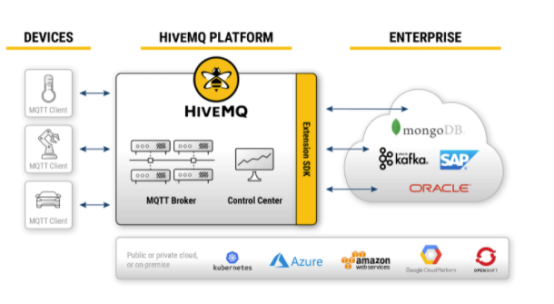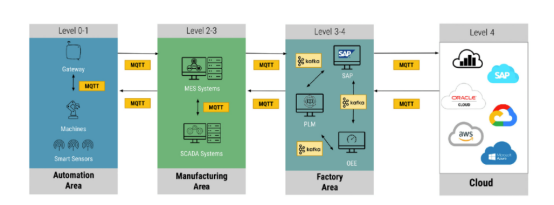
HiveMQ
Move Data to and from Connected Devices in an Efficient, Fast and Reliable Manner
The MQTT protocol is the de-facto standard for IoT messaging. Standardized by OASIS and ISO, MQTT publish/subscribe protocol provides a scalable and reliable way to connect devices over the Internet. Today, MQTT is used by many companies to connect millions of devices to the Internet.

Companies are using MQTT because

Key Features of HiveMQ MQTT Broker
HiveMQ is an MQTT broker and a client based messaging platform designed for the fast, efficient and reliable movement of data to and from connected IoT devices. It uses the MQTT protocol for instant, bi-directional push of data between your device and your enterprise systems.

HiveMQ is built to address some of the key technical challenges organizations face when building new Internet of Things applications, including:
1、Building reliable and scalable business critical IoT applications
2、Fast data delivery to meet the expectations of end users for responsive IoT products
3、Lower cost of operation through efficient use of hardware, network and cloud resources
4、Integrating IoT data into existing enterprise systems
HiveMQ MQTT broker instances scale with the underlying hardware. The non-blocking and multi-threaded approach allows up to 10,000,000 concurrent device connections while maintaining extremely fast throughput and adding minimal latency.
Data delivery over unreliable networks can be a challenge. HiveMQ implements all MQTT Quality of Service levels, including at most once, at least once and exactly once delivery. HiveMQ's support for advanced message retention policies and offline message queuing are essential to accommodate network latency.
HiveMQ is architected with a truly distributed and masterless cluster architecture, which means there is no single point of failure and the cluster can grow and shrink at runtime without losing data or availability. Support for Kubernetes, OpenShift and DC/OS make it possible to automatically scale HiveMQ to meet the requirements of your IoT application.
HiveMQ is designed to secure the IoT data from device to enterprise systems. Data transport is secured by industry standards like TLS 1.3, secure websockets and state-of-the-art cipher suites. Support for authentication and authorization includes, X.509 certs, username/password, IP-based authentication, and an API that allows for custom authentication, authorization and permission logic such as OAuth 2.0 integration.
HiveMQ's MQTT broker is 100% compliant with the MQTT 3.1, MQTT 3.1.1 and MQTT 5 specification. We also allow MQTT 3 and MQTT 5 clients to communicate with HiveMQ at the same time. All advanced features like topic wildcards, persistent sessions with offline queuing, retained messages and all Quality of Service levels are available at scale.
HiveMQ can be deployed on a private, hybrid and public cloud. Pre-built images can be deployed on private clouds using Kubernetes, OpenShift and DC/OS. The supported public cloud platforms include AWS and MS Azure. HiveMQ can also run natively on Linux, Windows and OS X.
Unlike HTTP, HiveMQ and MQTT is based on a pub-sub architecture so the total network traffic is reduced since there is no client polling. MQTT message size is also significantly smaller than HTTP so the amount of data passing through the network is reduced.
Enterprise data integration is achieved through bi-directional transmission of data between a HiveMQ MQTT broker and an enterprise system that act as an MQTT client. Using MQTT pub-sub protocol, each enterprise systems' MQTT client subscribes to the data that needs to be integrated. HiveMQ's MQTT Shared Subscription implementation makes it possible to horizontally scale the MQTT clients so the enterprise integration is scalable and reliable.
Administrators can use HiveMQ dashboard to monitor the real-time data passing through the MQTT broker and MQTT clients connected to your IoT application. For each MQTT client, an administrator can see a 360° overview of the client status, disconnect a client, remove the MQTT session, and add/remove subscriptions. For advanced troubleshooting, HiveMQ allows you to create trace recordings that can be used to identify issues and bottlenecks in your deployed IoT applications. An overall summary dashboard gives an operation team the complete real-time overview of the broker cluster and general health of the system.
An open API and a flexible extension framework makes it possible to integrate HiveMQ and your IoT data into existing enterprise systems. The extension framework allows developers to quickly create extensions for custom data processing, device authentication and device authorization mechanism. HiveMQ also provides a marketplace of pre-built extensions for Kafka, Oracle DB, MongoDB and other systems.
Any MQTT compliant client library can be used with HiveMQ. HiveMQ provides our own Java client library but you can also use Eclipse Paho, C/C++, JavaScript or Python libraries. Some of our customers also create their own custom MQTT clients. Different options for MQTT client means you don't get locked-in to one vendor.
HiveMQ Cloud is our cloud native IoT messaging service that simplifies the deployment and management of MQTT platforms. Our fully managed MQTT Cloud Platform creates scalable and reliable MQTT cloud-broker clusters that are built for production - with just a few clicks.
Modernizing the Manufacturing Industry with MQTT
Smart manufacturing is driving the manufacturing industry to modernize its software infrastructure. Whether you call it Industry 4.0 or the Industrial Internet of Things (IIoT), manufacturing is in the midst of a significant transformation. A key motivation in this push to modernize is that real-time data and dynamic decision-making yield meaningful performance improvements for businesses.
Current manufacturing infrastructure is costly to maintain, creates barriers to the distribution of data, integrates poorly with other systems, and blocks corporations from capitalizing on the advantages that digitalization creates. Successful transition to the next generation of manufacturing will require the adoption of new technologies that can integrate outdated existing systems with modern new systems.
In this whitepaper, we investigate the business drivers for modernization, technical challenges of adopting new technology, important emerging architecture patterns for modernizing software infrastructure, and recommendations for linking the different levels of automation in a factory with new MQTT-based messaging infrastructure. The goal of this whitepaper is to provide guidance to senior technology leaders in the manufacturing industry on how MQTT can serve as the key technology for developing the modern connected factory.
Business Drivers for Modernization
The end result of the drive toward modernization is the digitization of manufacturing.

© Copyright 2000-2025 COGITO SOFTWARE CO.,LTD. All rights reserved